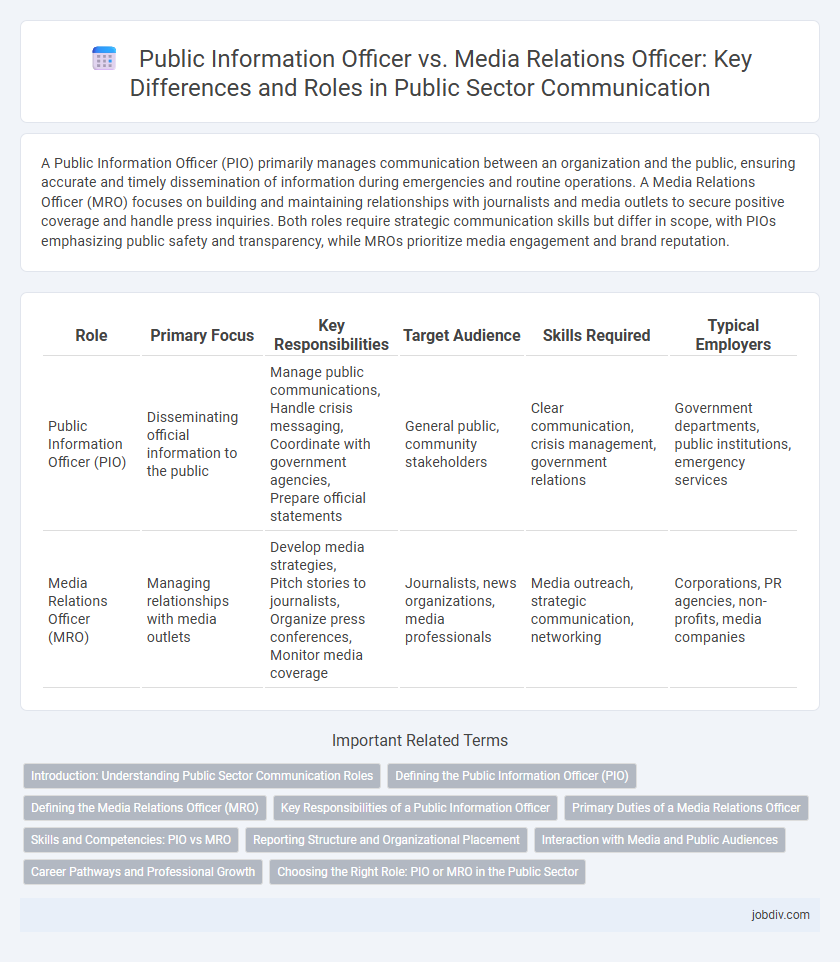A Public Information Officer (PIO) primarily manages communication between an organization and the public, ensuring accurate and timely dissemination of information during emergencies and routine operations. A Media Relations Officer (MRO) focuses on building and maintaining relationships with journalists and media outlets to secure positive coverage and handle press inquiries. Both roles require strategic communication skills but differ in scope, with PIOs emphasizing public safety and transparency, while MROs prioritize media engagement and brand reputation.
Table of Comparison
| Role | Primary Focus | Key Responsibilities | Target Audience | Skills Required | Typical Employers |
|---|---|---|---|---|---|
| Public Information Officer (PIO) | Disseminating official information to the public |
Manage public communications, Handle crisis messaging, Coordinate with government agencies, Prepare official statements |
General public, community stakeholders | Clear communication, crisis management, government relations | Government departments, public institutions, emergency services |
| Media Relations Officer (MRO) | Managing relationships with media outlets |
Develop media strategies, Pitch stories to journalists, Organize press conferences, Monitor media coverage |
Journalists, news organizations, media professionals | Media outreach, strategic communication, networking | Corporations, PR agencies, non-profits, media companies |
Introduction: Understanding Public Sector Communication Roles
Public Information Officers (PIOs) manage communication strategies for government agencies, ensuring transparent dissemination of accurate information to the public and media. Media Relations Officers specialize in maintaining relationships with journalists, crafting press releases, and coordinating media coverage to promote organizational objectives. Both roles are critical in shaping public perception and fostering trust between public sector entities and their audiences.
Defining the Public Information Officer (PIO)
The Public Information Officer (PIO) serves as the primary liaison between an organization and the public, responsible for disseminating accurate and timely information during emergencies and routine operations. The PIO's core duties include managing communication strategies, engaging with media outlets, and ensuring the public receives clear, credible updates. Unlike a Media Relations Officer who primarily focuses on cultivating media relationships and promoting an organization's image, the PIO prioritizes transparency and public safety through effective information management.
Defining the Media Relations Officer (MRO)
The Media Relations Officer (MRO) is a specialized communications professional responsible for managing and facilitating the relationship between an organization and the media. Their key duties include crafting press releases, coordinating interviews, and controlling the flow of information to ensure accurate and favorable media coverage. Unlike a Public Information Officer, who may handle broader public communication, the MRO's primary focus is targeted media engagement and strategic messaging.
Key Responsibilities of a Public Information Officer
A Public Information Officer (PIO) is primarily responsible for managing the dissemination of accurate, timely, and relevant information to the public and media, ensuring transparency and trust. Their key duties include crafting official statements, responding to information requests, and coordinating communication during emergencies or public events. Unlike a Media Relations Officer who focuses on building media connections and promoting organizational image, the PIO maintains the integrity and clarity of public information on behalf of government agencies or public institutions.
Primary Duties of a Media Relations Officer
A Media Relations Officer primarily manages communication between an organization and the media, crafting press releases, coordinating interviews, and maintaining strong relationships with journalists to ensure accurate coverage. They focus on shaping public perception by proactively distributing timely and relevant information to various media outlets. Unlike Public Information Officers who handle broader information distribution to the public and government agencies, Media Relations Officers specialize in media engagement and strategic media outreach.
Skills and Competencies: PIO vs MRO
Public Information Officers (PIOs) excel in crisis communication, policy dissemination, and community engagement with strong skills in clear, concise messaging and information verification. Media Relations Officers (MROs) focus on building and maintaining media contacts, press release development, and strategic media planning, requiring expertise in pitch creation and media monitoring. Both roles demand exceptional interpersonal communication, adaptability, and a thorough understanding of public perception management but differ in their primary interaction focus--PIOs with the public and MROs with media professionals.
Reporting Structure and Organizational Placement
A Public Information Officer (PIO) typically reports directly to senior management or a communications director, positioned within the public affairs or communications department to handle government or public sector information dissemination. In contrast, a Media Relations Officer (MRO) often operates within the marketing or public relations division, reporting to the communications manager, focusing more on media liaison and press coverage. Organizationally, PIOs have a mandate centered on transparency and public accountability, while MROs prioritize brand image and media engagement strategies.
Interaction with Media and Public Audiences
Public Information Officers (PIOs) primarily manage the flow of information between organizations and the public, ensuring accurate and timely dissemination through press releases and official statements. Media Relations Officers (MROs) focus on building and maintaining relationships with journalists and media outlets to secure positive coverage and manage media inquiries. Both roles require strategic interaction with media and public audiences but emphasize different communication channels and engagement techniques.
Career Pathways and Professional Growth
Public Information Officers often advance through roles in government communication, emergency management, and public affairs, developing expertise in crisis messaging and public outreach. Media Relations Officers typically build careers within corporate communications, PR agencies, or nonprofit organizations, honing skills in media strategy, press release writing, and stakeholder engagement. Both career pathways offer professional growth through certifications, specialized training, and expanding networks in public communication sectors.
Choosing the Right Role: PIO or MRO in the Public Sector
Public Information Officers (PIOs) specialize in disseminating official information and managing communications during emergencies, ensuring transparency and public trust within government agencies. Media Relations Officers (MROs) focus on cultivating relationships with journalists and managing the organization's public image through proactive media engagement and strategic messaging. Selecting the appropriate role depends on whether the primary need is crisis communication and information dissemination (PIO) or ongoing media interaction and reputation management (MRO).
Public Information Officer vs Media Relations Officer Infographic

 jobdiv.com
jobdiv.com